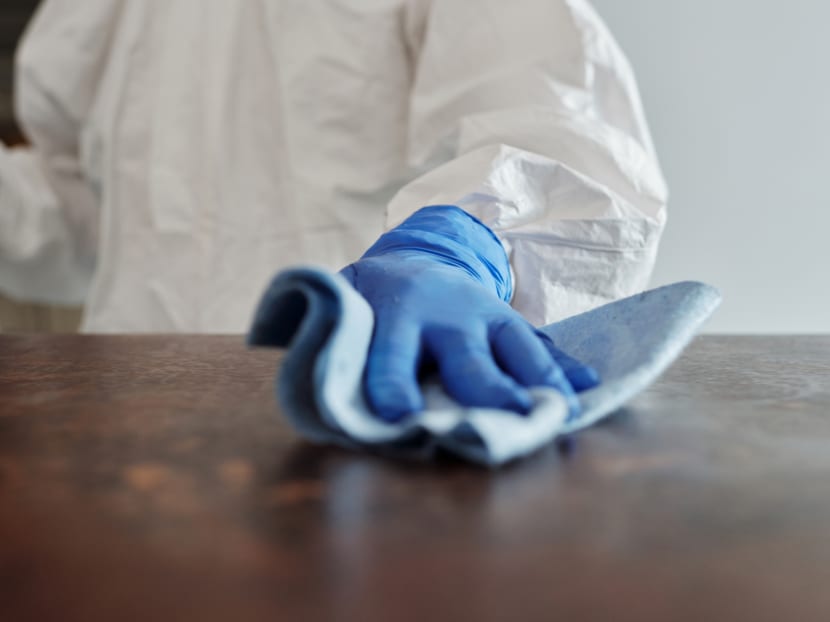Study shows coronavirus present in living spaces of Covid-19 patients, reaffirms need for disinfections: NEA
SINGAPORE — A study carried out by the National Environment Agency (NEA) found that the coronavirus that causes Covid-19 can linger on surfaces in the living spaces of infected patients, and this backs up the need for people to thoroughly disinfect such spaces.

To help owners and operators of non-healthcare premises better handle disinfections, NEA has issued a set of interim guidelines on how to clean areas that have been exposed to infected patients, as well as an interim list of household products and active ingredients for disinfecting contaminated surfaces.
SINGAPORE — A study carried out by the National Environment Agency (NEA) found that the coronavirus that causes Covid-19 can linger on surfaces in the living spaces of infected patients, and this backs up the need for people to thoroughly disinfect such spaces.
In a news release on Friday (May 22), NEA said that the study took 400 samples from frequently touched areas in non-healthcare accommodations used by Covid-19 patients, which include surfaces in rooms, toilets and elevators.
Out of the 400 samples, two were found to be positive with the Sars-CoV-2 virus that causes the respiratory disease.
The two samples were taken from the bedside wall and bed handle in the room of one of the confirmed cases before the place was disinfected. This low positive rate could be due to the cleaning regimes implemented in Singapore since the beginning of the outbreak, NEA said.
After the room was disinfected, a sampling of the same surfaces yielded no trace of the virus.
“As Covid-19 can be acquired through contact with surfaces contaminated with Sars-CoV-2, effective disinfection of spaces exposed to Covid-19 cases is therefore critical,” NEA said.
The study was conducted by the Environmental Health Institute (EHI), a public health laboratory run by NEA, and was led by its research scientist Judith Wong.
Dr Wong said: “While we did not see widespread contamination, our results show that Sars-CoV-2 can linger on surfaces in the living spaces of Covid-19 cases.”
She added that laboratory tests by other researchers have shown that the virus can survive on environmental surfaces for “two or three days”.
“Disinfection of spaces where Covid-19 cases dwell is thus essential, and ensuring environmental hygiene through regular cleaning of places with high footfall will minimise the risk of transmission through contact with contaminated surfaces.”
EFFECTIVE DISINFECTION
To prevent the spread of the coronavirus, NEA recommended wiping down surfaces with an effective disinfectant and stressed that the way the disinfectant is applied is important.
The use of handheld mist-sprays and electrostatic sprayers for disinfection is “not adequate on their own” and should only be used to supplement a wipe-down, it added.
The agency said that it has “not received any robust scientific evidence” to support the effectiveness of automatic misting systems and surface coatings that protect against the coronavirus.
Products that have been shown to reduce bacteria, adenosine triphosphate (ATP) — an organic compound found in living cells — or other virus counts are also not necessarily effective.
This is because “bacteria and different viruses differ in their biological and chemical make-up, and viruses do not contain ATP”, NEA said.
Furthermore, the application of processes such as whole-room fumigation and ultraviolet (UV) radiation is effective only if used in specific settings, such as in hospitals and laboratories.
“They must only be executed by trained professionals, as the processes are complex and exposure to chemical vapours and UV can cause harm.”
To help owners and operators of non-healthcare premises better handle disinfections, NEA has issued a set of interim guidelines on how to clean areas that have been exposed to infected patients, as well as an interim list of household products and active ingredients for disinfecting contaminated surfaces.
For cleaning areas where patients have stayed or areas that were exposed to infected persons, it lists the protective gear that cleaners have to wear and the instructions on how to clean and sanitise, as well as a list of companies that carry out disinfection work.
NEA has also published on its website an advisory to assist suppliers and users in making informed decisions when buying cleaning and disinfection products.
“When choosing a disinfectant for use against coronaviruses, suppliers and users must understand the efficacy of the active ingredient(s), the effectiveness and limitations of the applications, and the potential hazards that accompany the product or application,” the agency said.








